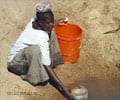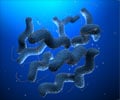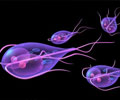Pathology
Four species of the Genus Shigella, which are pathogens to both man and other primates, are Shigella sonnei, Shigella flexneri, Shigella dysenteriae, and Shigella boydii. The passage of infection is via the fecal - oral route.

Microscopic view of Shigella bacteria
The bacterium injects IpaD protein to gain entry into the cell. Subsequently, using IpaB and IpaC proteins, the bacteria causes lysis of the vacuolar membranes. They multiply within the lumen of the gut. For its motility, the bacterium uses IcsA protein and successfully progresses forward in cell-to-cell propulsion.
They spread to adjacent cells and deep into the lamina to produce a toxic substance called "exotoxin". This toxin induces water and electrolyte loss from the intestinal cells leading to their dehydration.
The extend of virulence in Shigella infection is determined by the:
- Invasion of the wall of the large intestine by the bacteria,
- Inflammatory reaction associated with the infection, and
- Quantity of the toxic "exotoxin" that is produced.
The infected cells are destroyed and slough off leading to the formation of ulcers in the intestine. White Blood Cells (WBCs) attack this area and are prominently visible when viewed under a microscope.












